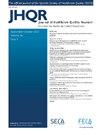Cataract care process: Systematic review of clinical guidelines and synthesis of recommendations
IF 1
Q4 HEALTH CARE SCIENCES & SERVICES
引用次数: 0
Abstract
Introduction
In 2020, 94 million people worldwide had moderate to severe visual impairment or blindness due to cataracts, particularly among older adults. The allocation of resources and appropriate strategies are essential for effective healthcare management that can control costs and improve patients’ quality of life. Clinical Practice Guidelines (CPGs) help reduce variability in care.
Objective
To analyze, compare, and synthesize recommendations from multiple guidelines on the same topic in order to identify consistencies, discrepancies, and opportunities for improvement.
Methods
Websites of international organizations, scientific societies, and various databases such as PubMed, WoS, and Cinahl were reviewed. A systematic review identified five high-quality CPGs for cataract management, with recommendations covering diagnosis, treatment, and postoperative follow-up.
Results
Although some variability was found, common recommendations were identified. Two widely agreed upon recommendations stood out: avoiding routine preoperative medical tests for local anesthesia, as they do not reduce complications, and using intracameral antibiotics (cefuroxime/moxifloxacin) for infection prevention, supported by high-level evidence, among others. The guideline developed by the American Academy of Ophthalmology – Cataract in the Adult Eye Preferred Practice Pattern – was found to be the most valid and useful.
Conclusion
Standardizing high-evidence recommendations can improve clinical decision-making, reduce variability, and enhance patient outcomes. This study highlights the need for better implementation strategies and patient-centered education to improve adherence to care.
白内障护理过程:临床指南的系统回顾和建议的综合。
2020年,全世界有9400万人因白内障出现中度至重度视力障碍或失明,尤其是老年人。资源分配和适当的策略对于有效的医疗保健管理至关重要,可以控制成本并改善患者的生活质量。临床实践指南(CPGs)有助于减少护理的可变性。目的:分析、比较和综合来自同一主题的多个指南的建议,以确定一致性、差异和改进机会。方法:查阅国际组织网站、科学学会网站以及PubMed、WoS、china等数据库。一项系统综述确定了5种用于白内障治疗的高质量cpg,并提供了包括诊断、治疗和术后随访的建议。结果:虽然发现了一些差异,但确定了共同的建议。其中有两项得到广泛同意的建议:避免术前常规的局部麻醉医学检查,因为它们不能减少并发症;以及使用内源性抗生素(头孢呋辛/莫西沙星)预防感染,这得到了高水平证据的支持。由美国眼科学会制定的指南——成人眼科首选实践模式中的白内障——被认为是最有效和有用的。结论:标准化高证据推荐可以改善临床决策,减少可变性,提高患者预后。本研究强调需要更好的实施策略和以患者为中心的教育,以提高对护理的依从性。
本文章由计算机程序翻译,如有差异,请以英文原文为准。
求助全文
约1分钟内获得全文
求助全文
来源期刊

Journal of Healthcare Quality Research
Medicine-Health Policy
CiteScore
1.70
自引率
8.30%
发文量
83
审稿时长
57 days
期刊介绍:
Revista de Calidad Asistencial (Quality Healthcare) (RCA) is the official Journal of the Spanish Society of Quality Healthcare (Sociedad Española de Calidad Asistencial) (SECA) and is a tool for the dissemination of knowledge and reflection for the quality management of health services in Primary Care, as well as in Hospitals. It publishes articles associated with any aspect of research in the field of public health and health administration, including health education, epidemiology, medical statistics, health information, health economics, quality management, and health policies. The Journal publishes 6 issues, exclusively in electronic format. The Journal publishes, in Spanish, Original works, Special and Review Articles, as well as other sections. Articles are subjected to a rigorous, double blind, review process (peer review)
 求助内容:
求助内容: 应助结果提醒方式:
应助结果提醒方式:


